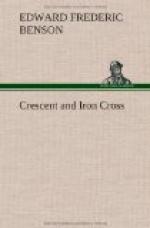’The last voyage I made before coming to this country was up the Nile from Khartoum to the Equatorial lakes. In this most desperate and forbidding region I was filled with pride to think I belonged to a race whose sons, even in this inhospitable waste of waters, were struggling in the face of a thousand discouragements to introduce new forest trees and new agricultural products and ameliorate in some degree the conditions of life of the naked and miserable inhabitants. How should I have felt, if in traversing the deserts and swamps which to-day represent what was the richest and most famous tract in the world, I had thought that I was the scion of a race in whose hands God has placed, for hundreds of years, the destinies of this great country, and that my countrymen could give no better account of their stewardship than the exhibition of two mighty rivers flowing between deserts to waste themselves in the sea for nine months of the year, and desolating everything in their way for the remaining three? No effort that Turkey can make can be too great to roll away the reproach of those parched and weary lands, whose cry ascends to heaven.’
But the harvests of Mesopotamia, when gathered in, must needs be transported, and for that railways are necessary. Water transport would, of course, carry them easily down to the Persian Gulf, but the supply will be mainly, if not wholly, wanted westwards, and it must be conveyed to the shores of the Mediterranean. Already, in preparation for world-conquest, Germany has proceeded far with her construction of the Bagdad Railway, which was intended, after her absorption of Turkey, to link up Berlin with her next Oriental objective, namely, India; the Taurus has been tunnelled, the Euphrates bridged, and but for a hiatus of a few miles the line is practically complete from Constantinople into Northern Mesopotamia. But its route was chosen for German strategic reasons, for the linking up of Berlin with Constantinople and Bagdad. This, it may be permitted to say, does not form part of the schemes of the Allies: it is to snap rather than weld such links that they have taken the field. What we want in the matter of railway transport for the harvests of Mesopotamia, and generally for our Eastern communications, is not a line that passes through Turkish and German soil, and terminates at Berlin, but one which, after the directest possible land-route, reaches the Mediterranean and terminates in suitable ports.
The reader therefore is requested to unthink the present Bagdad Railway altogether, to ‘scrap’ it in his mind, as it will be probably scrapped on the map, since it is utterly useless for our purposes. For taking Aleppo as (roughly) the half-way house in the existent line, we find that the western half of it lies in Asia Minor, in territory which, as we shall see, will remain Turkish, while the eastern half of it makes a long detour instead of striking directly for Bagdad. After our experience with Turkey




